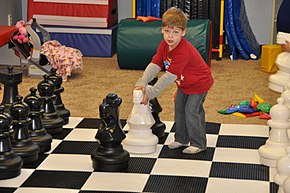
The touch-move rule in chess specifies that a player, having the move, who deliberately touches a piece[a] on the board must move or capture that piece if it is legal to do so. If it is the player's piece that was touched, it must be moved if the piece has a legal move. If the opponent's piece was touched, it must be captured if it can be captured with a legal move. If the touched piece cannot be legally moved or captured, there is no penalty. This is a rule of chess that is enforced in all formal over-the-board competitions.
A player claiming a touch-move violation must do so before themselves touching a piece.[2] A player who wants to adjust a piece on its square without being required to move it can announce the French j'adoube ("I adjust") before touching the piece.[3] While j'adoube is internationally understood, a local language equivalent such as "adjusting" is usually acceptable. A player may not touch the pieces on the board during the opponent's turn.
There is a separate rule that a player who lets go of a piece after making a legal move cannot retract the move. Thus, touching a piece that can be legally moved or captured commits the player to moving or capturing that piece.
Online chess does not use the touch rule, letting players "pick up" a piece and then bring it back to the original square before selecting a different piece, and also allowing players to premove pieces while waiting for the opponent to move.
Cite error: There are <ref group=lower-alpha> tags or {{efn}} templates on this page, but the references will not show without a {{reflist|group=lower-alpha}} template or {{notelist}} template (see the help page).
- ^ "FIDE Handbook E. Miscellaneous / 01. Laws of Chess / FIDE Laws of Chess taking effect from 1 January 2018". FIDE. Retrieved 12 July 2020.
- ^ Article 4.8 in FIDE Laws of Chess[1]
- ^ Hooper & Whyld 1992, p. 425.